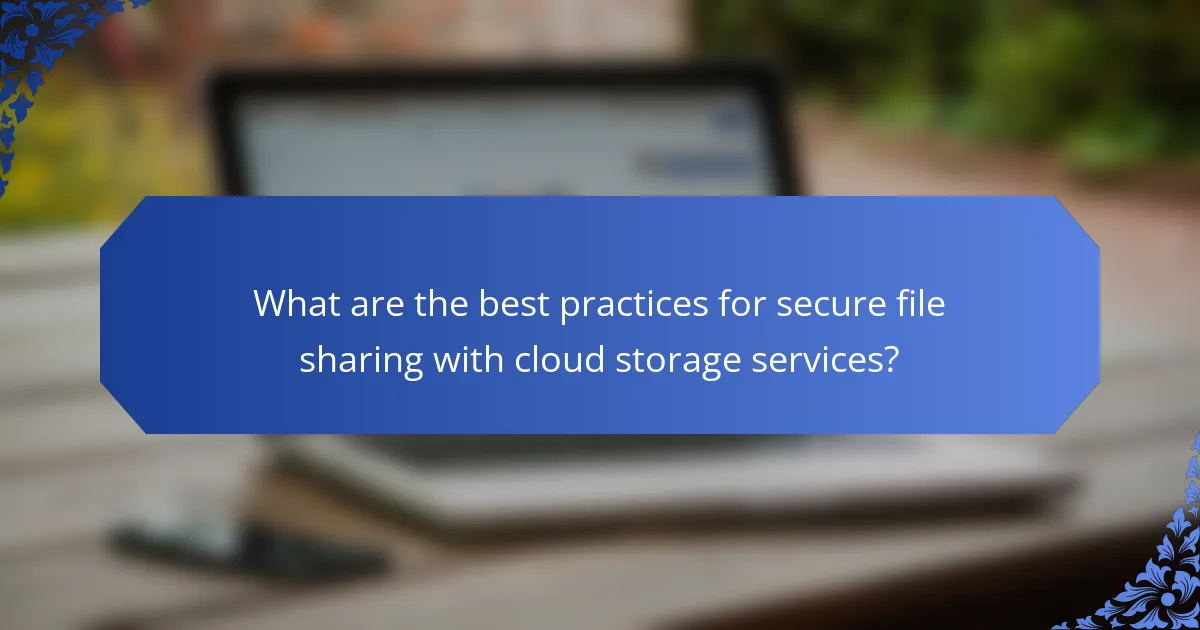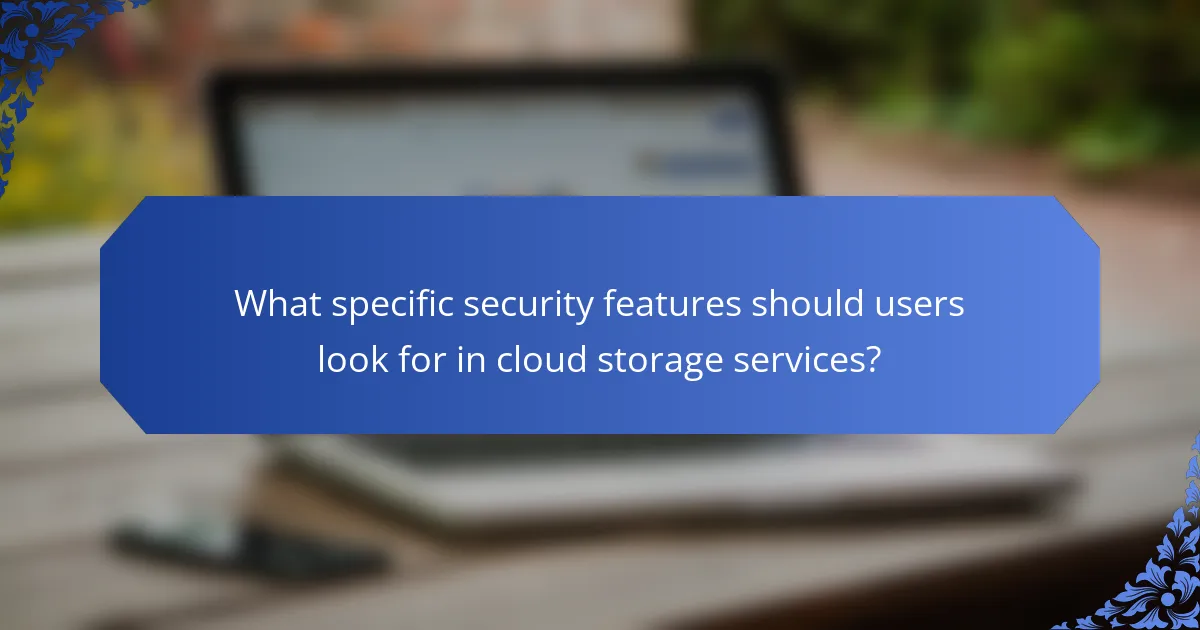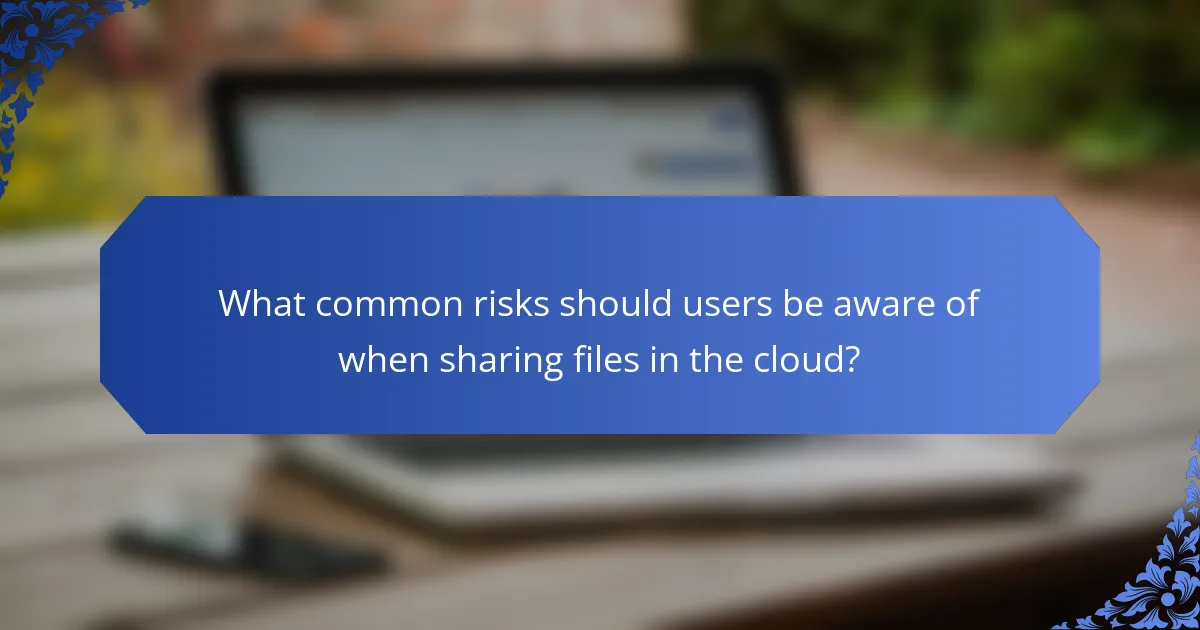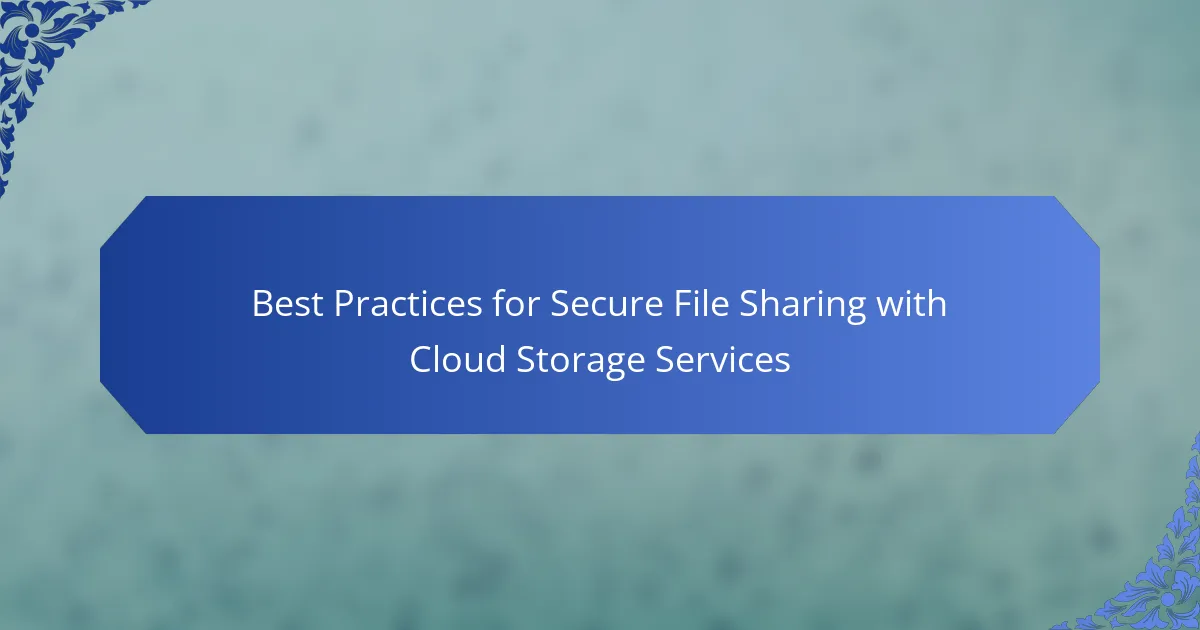Secure file sharing with cloud storage services is essential for protecting sensitive data from unauthorized access and data breaches. Key practices include using strong encryption for files during upload, implementing two-factor authentication for account access, and sharing files through secure links with expiration dates. Regularly reviewing access permissions and monitoring file access logs are crucial for maintaining security. Additionally, users should choose reputable cloud storage providers that comply with industry standards and conduct regular security audits to identify vulnerabilities. Awareness of common risks, such as data loss and phishing attacks, further emphasizes the need for robust security measures in cloud file sharing.

What are the best practices for secure file sharing with cloud storage services?
Use strong encryption for files before uploading them to cloud storage. This protects data during transfer and storage. Implement two-factor authentication for account access. This adds an extra layer of security beyond just passwords. Share files using secure links with expiration dates. This limits access duration and enhances security. Regularly review permissions for shared files. This ensures only authorized users have access. Monitor file access logs for unusual activity. This helps detect potential security breaches. Use reputable cloud storage providers with strong security measures. They should comply with industry standards like GDPR or HIPAA.
How can users ensure the confidentiality of shared files?
Users can ensure the confidentiality of shared files by implementing strong encryption methods. Encryption transforms files into a secure format that only authorized users can access. Users should utilize end-to-end encryption to protect files during sharing. This ensures that files remain secure from unauthorized access. Additionally, using secure passwords for file sharing adds another layer of protection. Regularly updating passwords enhances security further. Employing two-factor authentication can also safeguard access to shared files. Research indicates that 80% of data breaches could be prevented with proper security measures, including encryption and strong passwords.
What encryption methods should be used for file sharing?
AES (Advanced Encryption Standard) should be used for file sharing. AES is widely recognized for its strong security and efficiency. It supports key sizes of 128, 192, and 256 bits. The U.S. government uses AES to protect classified information. RSA (Rivest-Shamir-Adleman) is another method suitable for secure file sharing. RSA is commonly used for secure data transmission. It relies on public and private key pairs for encryption. TLS (Transport Layer Security) is essential for securing data in transit. TLS encrypts the connection between the sender and receiver. These encryption methods ensure that shared files remain confidential and secure.
How does end-to-end encryption enhance security?
End-to-end encryption enhances security by ensuring that only the communicating users can read the messages. This method encrypts data on the sender’s device and only decrypts it on the recipient’s device. No intermediaries, including service providers, can access the unencrypted data. This significantly reduces the risk of data breaches and unauthorized access. A study by the Electronic Frontier Foundation indicates that end-to-end encryption can prevent eavesdropping by third parties. Therefore, it provides a robust layer of security for sensitive information shared through cloud storage services.
What role do access controls play in secure file sharing?
Access controls are essential for secure file sharing as they regulate who can view or edit shared files. They help prevent unauthorized access to sensitive information. By assigning permissions, organizations can control access at various levels, such as read, write, or delete. This ensures that only authorized users can interact with the files. Access controls can be implemented through user authentication methods, like passwords or multi-factor authentication. Additionally, detailed logging of access attempts provides an audit trail for security monitoring. According to a report by the Ponemon Institute, 60% of data breaches involve unauthorized access, highlighting the importance of robust access controls.
How can users set permissions for shared files?
Users can set permissions for shared files through the file sharing settings in their cloud storage service. Most services allow users to specify who can view, edit, or comment on the files. Users can typically access these settings by right-clicking the file and selecting ‘Share’ or ‘Permissions.’ From there, they can enter email addresses or select users from a list. Additionally, users can often choose permission levels, such as ‘Viewer,’ ‘Editor,’ or ‘Commenter.’ Some platforms also offer expiration dates for access or password protection for added security. These features ensure that only authorized individuals can access sensitive files.
What are the implications of sharing links versus direct access?
Sharing links allows broader access to files without needing individual permissions. This can facilitate collaboration but may compromise security. Direct access requires specific user permissions, enhancing control over who can view or edit files. This method reduces the risk of unauthorized access. Links can be shared easily but may lead to unintended distribution. Direct access limits exposure by ensuring only designated users can access the files. According to a study by the International Journal of Information Management, 60% of data breaches occur due to link sharing. Therefore, choosing between links and direct access significantly impacts file security and user management.
Why is it important to regularly review shared files?
Regularly reviewing shared files is crucial for maintaining data security and integrity. It helps identify unauthorized access or changes to sensitive information. Regular reviews ensure compliance with data protection regulations. They also allow for the removal of outdated or irrelevant files. This practice minimizes the risk of data breaches. A study by the Ponemon Institute found that 60% of data breaches involved unprotected files. Regularly reviewing shared files can significantly reduce this risk.
What steps should be taken to audit shared documents?
To audit shared documents, first, identify all shared documents and their access permissions. Next, review the access logs to track who accessed the documents and when. Then, assess the current permissions to ensure they align with user roles. After that, verify document versions to confirm that only the latest version is accessible. Additionally, check for any unauthorized changes or edits made to the documents. Finally, document your findings and implement necessary changes to enhance security. Regular audits should be scheduled to maintain ongoing security.
How can users revoke access to files effectively?
Users can revoke access to files effectively by using the sharing settings in their cloud storage service. Most cloud platforms, like Google Drive and Dropbox, offer options to manage file permissions. Users should navigate to the shared file or folder and select the sharing settings. They can then choose to remove specific users or change their access level. For instance, users can switch from “Editor” to “Viewer” or completely remove access. This process ensures that only authorized individuals can access the files. Additionally, users should regularly review shared files to maintain security. Regular audits help identify and revoke unnecessary access promptly.
How does user education impact secure file sharing?
User education significantly enhances secure file sharing by equipping individuals with necessary knowledge and skills. Educated users are more likely to recognize security threats such as phishing and malware. They can implement best practices like using strong passwords and enabling two-factor authentication. Research indicates that organizations with trained employees experience 70% fewer security incidents. Additionally, user education fosters a culture of security awareness, encouraging proactive behavior. This results in safer sharing practices and reduced risk of data breaches. Overall, informed users contribute to a more secure file sharing environment.
What tools can assist in maintaining secure file sharing practices?
Encryption software can assist in maintaining secure file sharing practices. Tools like VeraCrypt and BitLocker encrypt files before sharing. This ensures that only authorized users can access the data. Secure file transfer protocols, such as SFTP and FTPS, protect files during transmission. They prevent interception by encrypting the data in transit. Additionally, cloud services with built-in security features, like Google Drive and Dropbox, offer secure sharing options. These platforms provide user permissions and activity tracking. Multi-factor authentication adds an extra layer of security to file access. Together, these tools enhance the safety of file sharing practices.

What specific security features should users look for in cloud storage services?
Users should look for encryption, both in transit and at rest, in cloud storage services. Encryption protects data from unauthorized access. It ensures that files are scrambled and unreadable without the correct decryption key. Additionally, users should consider multi-factor authentication (MFA). MFA adds an extra layer of security by requiring additional verification beyond just a password. Another important feature is access controls. These controls allow users to specify who can view or edit files. Regular security audits are also essential. They help identify vulnerabilities and ensure compliance with security standards. Lastly, users should check for data redundancy and backup options. This ensures data recovery in case of loss or breach.
How do two-factor authentication and multi-factor authentication enhance security?
Two-factor authentication (2FA) and multi-factor authentication (MFA) enhance security by requiring additional verification beyond just a password. 2FA typically combines something the user knows, like a password, with something the user has, such as a mobile device for a verification code. This method significantly reduces the risk of unauthorized access.
MFA expands on this by incorporating multiple verification methods, which may include biometrics, security tokens, or location-based verification. By adding layers of security, MFA makes it increasingly difficult for attackers to gain access.
Research shows that accounts with 2FA are 99.9% less likely to be compromised. A study by Google indicated that implementing 2FA can prevent 80% of account hacks. Thus, both 2FA and MFA provide robust defenses against unauthorized access and enhance overall security.
What are the differences between two-factor and multi-factor authentication?
Two-factor authentication (2FA) requires two distinct forms of verification. Multi-factor authentication (MFA) involves two or more verification methods. 2FA typically combines something you know, like a password, with something you have, such as a mobile device. MFA can include additional factors, such as biometrics or location-based verification.
The primary difference lies in the number of authentication factors used. 2FA is a subset of MFA. MFA provides greater security by utilizing multiple factors. This makes it more difficult for unauthorized access. According to the National Institute of Standards and Technology, MFA significantly reduces the risk of account compromise.
How can users set up these authentication methods?
Users can set up authentication methods by accessing the security settings of their cloud storage service. They should look for options like two-factor authentication (2FA) or multi-factor authentication (MFA). Users typically need to provide their phone number or email for verification. After entering this information, they will receive a code to confirm their identity. Following this, they may need to download an authentication app for enhanced security. Users should ensure they follow all prompts to complete the setup. This process significantly reduces unauthorized access to their files. Implementing these methods is a crucial step in maintaining secure file sharing practices.
What security certifications should cloud storage services have?
Cloud storage services should have certifications such as ISO 27001, SOC 2, and GDPR compliance. ISO 27001 ensures a systematic approach to managing sensitive information. SOC 2 focuses on data security, availability, and confidentiality. GDPR compliance is crucial for services operating in or serving clients in the European Union. These certifications demonstrate a commitment to security best practices and regulatory requirements. They provide assurance to users that their data is handled with care and in accordance with established standards.
What does compliance with GDPR or HIPAA mean for file sharing security?
Compliance with GDPR or HIPAA means that file sharing security must adhere to strict data protection standards. GDPR requires organizations to protect personal data and privacy of EU citizens. HIPAA mandates safeguarding sensitive health information in the United States. Both regulations necessitate encryption of data during transmission and at rest. They also require access controls to limit who can view or edit shared files. Regular audits and risk assessments are essential for compliance. Non-compliance can lead to significant fines and legal repercussions. Adhering to these regulations enhances trust and accountability in file sharing practices.
How can users verify a cloud service’s security certifications?
Users can verify a cloud service’s security certifications by checking the provider’s official documentation. This documentation often includes details about compliance with standards like ISO 27001 or SOC 2. Users should look for certificates that are publicly available on the provider’s website. Many reputable cloud services also provide third-party audit reports. These reports validate their adherence to security standards. Users can request these documents directly from the service provider if they are not readily accessible. Additionally, users can consult industry-specific compliance requirements that the service claims to meet. This ensures that the cloud service aligns with relevant regulations.

What common risks should users be aware of when sharing files in the cloud?
Common risks when sharing files in the cloud include data breaches, unauthorized access, and data loss. Data breaches occur when sensitive information is accessed by unauthorized individuals. According to a 2021 report by IBM, the average cost of a data breach is $4.24 million. Unauthorized access can happen if sharing permissions are not properly managed. Users may inadvertently share files with the wrong people, leading to potential misuse. Data loss can occur due to accidental deletion or service outages. A study by Gartner indicates that 70% of organizations have experienced data loss in the cloud. Users should also be aware of phishing attacks that target cloud storage credentials. These risks highlight the importance of implementing strong security measures when sharing files in the cloud.
How can phishing attacks compromise file sharing security?
Phishing attacks can compromise file sharing security by tricking users into providing sensitive information. Attackers often use deceptive emails or messages that appear legitimate. These messages may contain links to fake login pages. When users enter their credentials, attackers gain unauthorized access to their accounts. This access can lead to data breaches and unauthorized file sharing. According to the Anti-Phishing Working Group, phishing attacks have increased significantly, affecting millions of users. Organizations must educate employees about identifying phishing attempts to mitigate these risks. Implementing multi-factor authentication can also enhance security against such attacks.
What are the signs of a phishing attempt related to file sharing?
Signs of a phishing attempt related to file sharing include unexpected emails requesting file access. These emails often contain suspicious links or attachments. The sender’s email address may look similar to a legitimate source but is slightly altered. Phishing attempts may also include urgent language prompting immediate action. Additionally, they may ask for personal information or login credentials. Another sign is poor spelling and grammar in the message. Legitimate organizations typically maintain a professional tone. Lastly, hovering over links may reveal mismatched URLs, indicating a potential scam.
How can users protect themselves from phishing attacks?
Users can protect themselves from phishing attacks by being vigilant and adopting specific security measures. They should verify the sender’s email address before clicking any links. Users must avoid clicking on suspicious links or downloading attachments from unknown sources. Implementing two-factor authentication adds an extra layer of security. Regularly updating passwords can help safeguard accounts. Additionally, users should educate themselves about common phishing tactics. Using security software that includes anti-phishing features is also advisable. According to the Anti-Phishing Working Group, phishing attacks increased by 22% in 2021, highlighting the importance of these protective measures.
What vulnerabilities exist in public cloud storage environments?
Public cloud storage environments face several vulnerabilities. These include data breaches, where unauthorized access leads to exposure of sensitive information. Misconfigured storage settings can also allow public access to private data. Inadequate encryption practices may leave data vulnerable during transfer and storage. Insider threats from employees with access can compromise security. Additionally, insecure APIs can be exploited to manipulate or steal data. According to a report by the Cloud Security Alliance, 64% of organizations experienced a cloud security incident in the past year. This highlights the critical need for robust security measures in public cloud storage.
How can users mitigate risks associated with public cloud storage?
Users can mitigate risks associated with public cloud storage by implementing strong security measures. First, they should use encryption for data at rest and in transit. This protects sensitive information from unauthorized access. Second, users must enable two-factor authentication for their accounts. This adds an extra layer of security beyond just passwords. Third, users should regularly update their software and applications. Keeping systems current helps protect against vulnerabilities. Fourth, users need to establish access controls and permissions. This limits who can view or edit files. Additionally, conducting regular security audits can identify potential risks. Lastly, users should be aware of the service provider’s compliance and security certifications. This ensures that the provider adheres to industry standards for data protection.
What are the best practices for using public Wi-Fi when accessing cloud storage?
Use a VPN to secure your connection when accessing cloud storage on public Wi-Fi. A VPN encrypts your internet traffic, making it difficult for hackers to intercept your data. Avoid accessing sensitive information or making financial transactions on public networks. Public Wi-Fi is often unsecured and can expose your data to risks. Enable two-factor authentication for your cloud storage accounts. This adds an extra layer of security beyond just a password. Regularly update your devices and applications to protect against vulnerabilities. Outdated software can have security flaws that hackers exploit. Always log out of your accounts after use to prevent unauthorized access. This simple step can protect your data from being accessed by others on the same network.
What practical tips can enhance secure file sharing with cloud storage services?
Use strong passwords and enable two-factor authentication for cloud storage accounts. This adds an extra layer of security. Regularly update passwords to maintain security integrity. Share files using secure links that expire after a set time. Avoid sharing sensitive files via email. Encrypt files before uploading to the cloud. This ensures data is protected during transit. Limit access to files by only sharing with necessary individuals. Regularly review shared files and permissions to ensure they are up-to-date. Implement monitoring tools to track access and changes to shared files. These practices significantly reduce the risk of unauthorized access and data breaches.
The main entity of the article is secure file sharing with cloud storage services. The article outlines best practices for enhancing file security, including the use of strong encryption, two-factor authentication, and secure sharing methods like expiring links. It emphasizes the importance of access controls, regular reviews of shared files, and user education to prevent unauthorized access and data breaches. Additionally, it discusses the role of encryption methods, compliance with security standards, and tools that can assist in maintaining secure file sharing practices. Users are also informed about common risks associated with cloud storage and practical tips for mitigating these risks.
